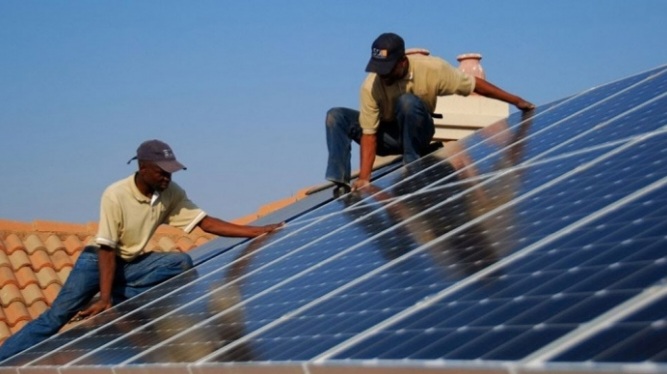10 Things to Know Before Installing Solar Panels in 2025
Installing solar panels in 2025 is one of the smartest energy decisions you can make. Solar energy not only reduces electricity bills but also provides energy independence, environmental benefits, and long-term savings.
However, installing a solar system is not just about placing panels on your roof. A poorly designed system can underperform, costing you money and time. Based on my experience as a professional solar installer, here are 10 crucial things you should know before installing solar panels, ensuring you make the best decision for your home or business.
For smart guidance throughout your solar journey, you can use the Globisun mobile app, which helps you calculate your power needs, explore solar products, and monitor your system.
1. Assess Your Energy Consumption in Detail
Understanding your energy usage is the foundation for a successful solar installation.
Steps to assess your needs:
- Review electricity bills for the past 12 months to track monthly consumption in kWh.
- Identify peak usage times, especially if you plan to include battery storage.
- List all electrical devices and their wattage—AC units, refrigerators, lights, pumps, and electronics.
- Account for potential future energy additions, such as electric vehicles or office expansion.
Calculation Example:
A standard 1 kW solar panel produces roughly 4 kWh/day under ideal conditions. A household consuming 40 kWh/day would need approximately 10 kW of panels. Seasonal variations and local weather patterns must also be considered.

2. Evaluate Your Roof or Installation Space Carefully
Placement and orientation significantly impact solar panel performance.
- Roof orientation: South-facing roofs (northern hemisphere) capture the most sunlight.
- Tilt angle: Align the panels close to your latitude for optimal year-round efficiency.
- Shading: Even small shadows can reduce efficiency by up to 25%.
- Roof condition: Ensure your roof is structurally sound before installation to avoid future issues.
If your roof isn’t suitable, ground-mounted solar systems are a strong alternative.

3. Calculate Your Budget and ROI
A solar system is a long-term investment.
Components to consider:
- Panels, inverter(s), mounting structures, wiring, batteries (optional), and installation labor.
- Cost per watt: In 2025, residential panels cost around $0.8–$1.2 per watt. A 5 kW system may cost $4,000–$6,000 before incentives.
ROI Example:
A home consuming 30 kWh/day at $0.12/kWh spends about $108/month on electricity. A 7 kW solar system producing 28–30 kWh/day can nearly offset this entire cost.
Smart planning ensures your solar system delivers maximum savings.

4. Understand Different Solar Panel Types
Choosing the right solar panels is critical for efficiency and cost-effectiveness.
- Monocrystalline: High efficiency (18–22%), space-efficient, long lifespan (~25 years).
- Polycrystalline: Slightly lower efficiency (15–18%), more affordable, needs more space.
- Bifacial: Captures sunlight on both sides, boosting output by 10–30%.
- Thin-film: Flexible, lightweight, lower efficiency (~10–12%), suitable for non-traditional surfaces.
Select panels that fit your space, budget, and long-term energy goals. You can also explore solar products and plan your system using the Globisun app.

5. Plan for Maintenance and Longevity
Solar panels require minimal maintenance but proper care ensures peak efficiency:
- Cleaning: Remove dust, leaves, and debris 2–4 times per year.
- Inverter monitoring: Track performance to detect errors early.
- Physical inspection: Check mounts, cracks, and water damage.
- Batteries: Follow manufacturer guidelines for charging cycles and replacement.
A well-maintained system can last 25+ years with minimal efficiency loss.

6. Understand Regulations and Incentives
Solar installation regulations vary by region.
- Permits: Most areas require approval for roof-mounted panels.
- Net metering: Some locations allow selling excess energy to the grid.
- Incentives: Check federal, state, or local rebates to reduce upfront costs.
Being aware of regulations ensures legal compliance and financial benefits.
7. Consider Weather and Sunlight Availability
Sunlight availability impacts solar panel efficiency:
- Daily solar irradiance: Determines how many panels you need.
- Seasonal variations: Winter months can reduce output by 20–30%.
- Extreme weather: Panels should withstand wind, hail, and heavy rain.

Monitoring tools can help track performance relative to expected sunlight.
8. Choose a Certified Installer
Professional installation ensures safety, durability, and maximum efficiency:
- Certifications: Look for recognized solar installation credentials.
- Experience: Check previous projects and customer reviews.
- Warranty: Ensure both panels and installation are covered.
Poor installation can lead to inefficiencies, leaks, or electrical hazards.

9. Plan for Future Expansion
Your energy needs may grow over time:
- Leave room for additional panels.
- Ensure your inverter can handle expansion.
- Consider scalable battery systems for off-grid or hybrid setups.
Planning ahead saves money and reduces system downtime.
10. Take Control of Your Energy Future
Installing solar panels is about more than reducing bills—it’s about energy independence. Modern systems allow you to monitor production, track usage, and manage efficiency.
For a simple way to plan, monitor, and explore solar options, the Globisun mobile app is a convenient companion, helping you calculate power needs, view solar products, and check your system status.
Conclusion
Installing solar panels in 2025 is a long-term investment that pays off through energy savings, independence, and sustainability. By understanding your energy consumption, choosing the right panels, planning your budget, and preparing for maintenance and expansion, you can maximize efficiency and future-proof your system.
Take charge of your energy future today—plan carefully, make informed choices, and get started with solar energy. To get a head start, you can download the Globisun mobile app and explore your solar options.






